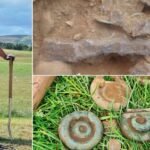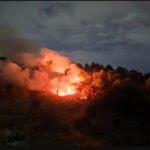Aviva-backed 100-year climate programme aims to stitch together rare temperate woodlands from Cornwall to the HighlandsBy [Staff Writer]
Published: May 5, 2025
A £40 million climate restoration project is set to transform the UK’s Atlantic edge—and Scotland’s long-overlooked temperate rainforests are finally being brought into the fold.
Insurance giant Aviva is funding the Wildlife Trusts’ new 100-year programme to restore and connect temperate rainforest habitat across Britain’s western coastline. The plan, now among the UK’s most ambitious nature-based climate strategies, will establish more than 1,700 hectares of coastal rainforest, stretching from Cornwall to the Highlands.
Although no specific Scottish sites have yet been confirmed, the country’s 30,000 hectares of surviving rainforest, much of it found in Argyll and the west coast, are central to the vision—both as threatened relics and as ecological anchors.
Rainforests on the Edge
Temperate rainforests, often called “Atlantic woodlands,” are among Europe’s rarest and most threatened habitats. Once spanning a fifth of the UK, they have shrunk to just 1% of land area, their loss driven by centuries of farming, grazing, and timber planting.
Scotland now holds about two-thirds of what remains, according to the Alliance for Scotland’s Rainforest (ASR). Yet even these surviving fragments face mounting threats: isolation, overgrazing by deer, non-native species like Rhododendron ponticum, and a changing climate.
“This is about more than restoration,” says Tara Cummins, programme coordinator at the Wildlife Trusts. “We’re talking about creating entirely new rainforest habitat, using native tree planting and natural regeneration, to help these woodlands survive the next century.”

Nature as Climate Infrastructure
Aviva’s investment is part of its £100 million portfolio aimed at climate resilience through nature-based solutions. The rainforest project alone is forecast to remove 800,000 tonnes of CO₂ over 100 years, while helping to regulate water flows, combat flooding, and improve biodiversity.
“Restoring wild places like these is critical for climate change—and that in turn underpins food security,” Cummins explains. “This isn’t about taking valuable farmland. We’re targeting degraded land that’s often been abandoned for years.”
The initiative arrives amid a charged national conversation about land use in the UK. Governments are juggling competing priorities—food production, housing, biodiversity, net-zero goals, and renewable energy—with limited space to satisfy them all.
The Long View
The Wildlife Trusts describe this as a multi-generational project. Over a century, the goal is to reconnect isolated fragments of rainforest, restore ecosystem functions, and create wildlife corridors that allow species to adapt to changing conditions.
“Temperate rainforest needs very specific conditions—mild, wet, and stable,” says Cummins. “But those pockets are becoming scarcer with climate change. So the only way to safeguard these systems is to link them together.”
As the project gains momentum, pressure is mounting to include Scottish pilot sites. Conservationists say west coast woodlands—particularly in Morvern, Knapdale, and Lochaber—are not just ideal, but essential.
According to Woodland Trust Scotland, restoring these sites offers a rare opportunity to lock in carbon while saving ancient ecosystems rich in lichens, bryophytes, and endemic species that thrive only in rainforest microclimates.
Local Challenges, Global Stakes
Yet the restoration will not be straightforward.
In Scotland, overgrazing by red deer and sheep continues to stifle regeneration. And non-native plants—especially Rhododendron ponticum—are choking understory growth and degrading native soils.
“Invasive species and unchecked grazing are the two biggest immediate threats,” says a spokesperson for ASR. “If we don’t control them, restoration work simply won’t stick.”
Policy support may be another obstacle. While Scottish ministers have committed to bold reforestation targets, a lack of funding and legal tools to manage deer populations and prevent land misuse continue to hamper action on the ground.
Still, optimism is growing that this high-profile, privately funded project could shift the momentum—especially with investors now seeing nature as climate-critical infrastructure.
An Ancient Forest, Reimagined
The UK’s rainforest is not a tropical canopy but a damp, moss-laden haven of oak, birch, holly, and hazel—home to rare species like the Scottish wildcat, chequered skipper butterfly, and hazel gloves fungus.
And it may yet prove a cornerstone in Britain’s net-zero future.
“What’s exciting here,” says Cummins, “is not just what we’re saving, but what we’re building—a living, breathing, carbon-storing system that will outlast us all.”

















